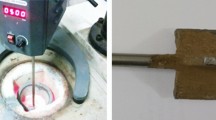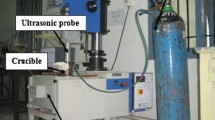Abstract
In this study, after producing metal matrix composite materials reinforced with ceramic particles by adding hard Al2O3 particles into a selected ageable aluminum alloy, the wear strengths were investigated. Composites of aluminum alloys containing 2 to 10 wt of Al2O3 particles in the size range of 23.4 to 108 μm were prepared by adding alumina particles to a partially-solid vigorously-agitated matrix alloy. For a given tribologic system, the sizes and ratios of optimum particles were determined from the point of the wear strengths of these materials, of which the wear strengths greatly increased according to the matrix materials. Alumina particles were subjected to preheating at 500°C for 8 hours. Particles were added into the alumina alloy heated up to semi-solid/semi-liquid phase interval in an argon medium by using a mixer. Then furnace temperature was raised up to 800°C step by step. Later the composite materials were die cast and solidified and aged. The behavior of the composites was studied by using a pin-on-disk type machine. The largest wear strengths were obtained at an average particle size of 76.5 μm and percentage of 4% wt Al2O3. Increase in the wear strength of the composites was obtained as 3.85 times the wear strength of the matrix material.
Résumé
Après avoir fabriqué des matériaux composites à matrice métallique, renforcés de particules céramiques, par l’ajout de particules dures d’Al2O3 dans un alliage d’aluminium soumis au vieillissement, on a conduit une étude sur leurs résistances à l’usure. Des composites d’alliages en aluminium, ayant une teneur de 2 à 10% (en poids) de particules d’Al2O3 de dimensions allant de 23,4 à 108 μm, ont été préparés par l’ajout de particules d’alumine à une matrice d’alliage partiellement solidifiée et vigoureusement agitée. Pour un système tribologique donné, les dimensions et les taux optimaux des particules ont été déterminés sur la base des résistances à l’usure des matériaux en question, dont les résistances se sont accrues de manière significative selon les matériaux des matrices. Les particules d’alumine ont été soumises à un préchauffage à 500 °C pendant 8 heures. Ensuite, elles ont été ajoutées à l’alliage alumine, préalablement chauffé jusqu’à la phase semi-solide/semi-liquide dans un milieu d’argon, au moyen d’un malaxeur. Ensuite, la température du four a été augmentée par paliers jusqu’à 800 °C. Plus tard, les matériaux composites ont été coulés sous pression, solidifiés et vieillis. Le comportement des composites a été étudié sur une machine d’essai à l’usure. Les meilleures résistances à l’usure ont été obtenues avec une particule ayant une dimension moyenne de 76,5 μm, à une teneur de 4% (en poids) de Al2O3. L’accroissement de la résistance des composites obtenue était de 3,85 supérieur à la résistance de la matrice.
Similar content being viewed by others
References
Demirci, A. H., ‘The investigation and optimization of wear strengths of sub-eutectoid unalloyed steels depending on heat treatments’, Post Doctorate Thesis, University of Aegean, Mechanical Engineering Faculty, Yzmir, 1982.
Surappa, M. K., Rohatgi, P. K., ‘Preparation of cast aluminum-ceramic particle composites’,Journal of Materials Science 16 (1981) 983–993.
Demirci, A. H., Güleç, S., ‘Mechanical properties-corrosion relation of an aged aluminum-Cu alloy and a sample of Ag influents on them’,Metall 42 (10) (1988) 977–980.
Demirci, A. H., ‘The effects on the change of mechanical properties of aging processes in a selected Al−Cu alloy (% 4.5 Cu)’, III. National Mechanical Design and Manufacturing Congress Proceedings, Middle East Technical University, Anakara, September, 1988, 633–639.
Demirci, A. H., ‘Untersuchungen zum Kavitations-verhalten einer Al−Cu-Legierung in Abhangigkeit von Alterungshartung’,Metall 43 (6) (1989) 525–532.
Hatch, J. E., ‘Aluminum: Properties and Physical Metallurgy’, (American Society For Metals, Metals Park, Ohio, 1984).
Ramani, G., Ramamohan, T. R., Pillai, R. M., Pai, B. C., ‘Stability of non-wetting dispersoid suspension in metallic melts’,Scripta Metallurgica et Materialia 24 (1990) 1419–1424.
Atik, E., ‘In an ageable Al−Al2O3 composite, the determination of optimum mechanical properties and production conditions according to the wearing strength’, Ph. D. Thesis, (Uludağ University, Science Institute, Bursa, 1994).
Demirci, A. H., Atik, E., ‘In aluminum alloy-Al2O3 composites the effects of particle ratios to mechanical properties’, 6th Denizli Material Science Symposium Proceedings, Denizli, April, 1995, 11–19.
Atik, E., ‘The effects of Al2O3 particle sizes and fractions on wear strength of Al alloy-Al2O3 composites’, 7th International Machine Design and Production Conference, Ankara, September, 1996 (Middle East Technical University, Ankara) 281–289.
Author information
Authors and Affiliations
Rights and permissions
About this article
Cite this article
Atïk, E. Mechanical properties and wear strengths in aluminium-alumina composites. Mat. Struct. 31, 418–422 (1998). https://doi.org/10.1007/BF02480716
Received:
Accepted:
Issue Date:
DOI: https://doi.org/10.1007/BF02480716




